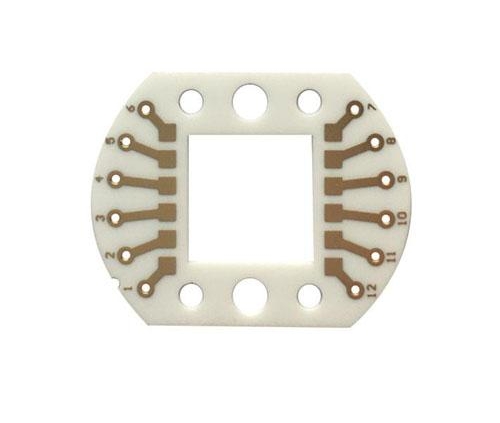What is DBC for ceramic copper-clad pcb?
Direct Bonding Copper is a new type of high-performance heat dissipation material. It is a heat dissipation material that organically combines a copper layer with a ceramic substrate. The copper layer can effectively spread and disperse heat, while the ceramic substrate has good Excellent insulation performance and high temperature stability. DBC has the characteristics of good thermal conductivity, high mechanical strength, good impact resistance, and high temperature resistance. It is widely used in electronic packaging, LED lighting, automotive electronics and other industries.
1. The structure of dbc
The main structure of DBC consists of three parts: metal copper layer, ceramic dielectric layer and metal solder. Among them, the metal copper layer is the main body for electrical conduction and heat dissipation. Its good electrical and thermal conductivity ensures the efficient heat dissipation effect of DBC during use. The metal copper layer adopts the chemical copper plating process, which can form a flat copper layer and have small plastic deformation pressure-sensitive properties, which can effectively maintain the stability of the copper layer throughout the product life cycle. The ceramic dielectric layer plays the role of insulation and mechanical support. Because of its lower thermal conductivity compared to the copper layer, it can ensure that it will not have a great impact on the thermal conductivity of the copper layer. Ceramic substrates mainly use alumina, silicon nitride, ceramic composite materials, etc. These ceramic substrates have the characteristics of good high temperature stability, high mechanical strength, and good corrosion resistance. The metal solder is mainly used to bond the copper layer and the ceramic substrate together, effectively providing the strength of the entire DBC product.
2. Preparation of dbc
The preparation of DBC mainly uses modern electrochemical copperization technology, by forming a layer of active metal substances on the surface of the ceramic substrate, so that the copper layer can be deposited while the copper layer is immersed in the active electrolyte. Commonly used ceramic substrate materials include aluminum oxide and silicon nitride. Among them, DAC-A03 is a ceramic substrate used for high-brightness technology, DAC-A05 is a ceramic substrate used for ordinary technology, and DAC-A07 is a ceramic substrate used for high-precision technology. Compared with silicon nitride, the surface of aluminum oxide is smoother, which can greatly improve the bonding degree and heat dissipation efficiency of the copper layer and the dielectric layer. The combination of ceramic substrate and copper layer mainly uses inkjet printing technology and shielding film technology. Both technologies can realize the preparation of customized DBC products. With the continuous improvement of preparation processes and technological advancement, the performance and stability of DBC products will be further improved.
3. Application of dbc
The applications of dbc mainly cover the fields of electronic packaging, LED lighting and automotive electronics. The field of electronic packaging has always been one of the main application fields of DBC. Because electronic equipment generates a large amount of heat during high-power operation, if the heat cannot be dissipated in a timely and effective manner, the equipment may work unstable or even be damaged. DBC has fast heat dissipation speed and excellent thermal conductivity, and has been widely used in the field of electronic packaging. For example, DBC products can be used in semiconductor power modules, high-power LEDs, power electronic devices, etc. In semiconductor power modules, DBC can be used to package IGBTs, MOSFETs, etc., and the long-term stability and reliability of these devices can be ensured through the DBC heat dissipation structure. With the popularity of LED lamps, dbc is increasingly used in the field of LED lighting. LED lamps also generate a large amount of heat during their working process. This heat can be quickly dissipated to the outside world through DBC, ensuring the high brightness and long life of the LED lamps. Automotive electronic equipment also needs to dissipate heat, and the efficient heat dissipation performance of DBC makes it widely used in the field of automotive electronics.
4. Development prospects of dbc
As a new type of heat dissipation material, DBC has extremely high market value and broad application prospects. With the continuous improvement of the performance of dbc products, it will be widely used in electronics, automobiles, aerospace, medical and energy and other fields. In the electronic field, the functions of electronic products are constantly strengthened and intelligent, which also puts forward higher requirements for heat dissipation performance. This requires dbc, as the main product in the field of electronic product heat dissipation, to continuously advance in technology to meet the needs of the market. . Another example is that in the energy field, DBC also has broad application prospects in solar cells, lithium batteries and fuel cells, because these devices also require an efficient heat dissipation system.
As a new type of heat dissipation material, DBC will be widely used in future development due to its superior heat dissipation performance. With the continuous advancement of technology and continued market demand, the application fields of dbc will become more extensive and the market prospects will become brighter.



